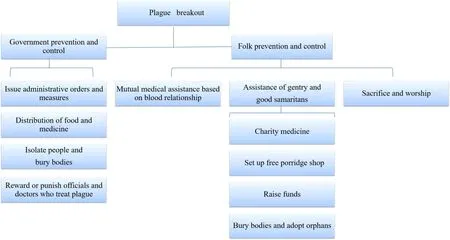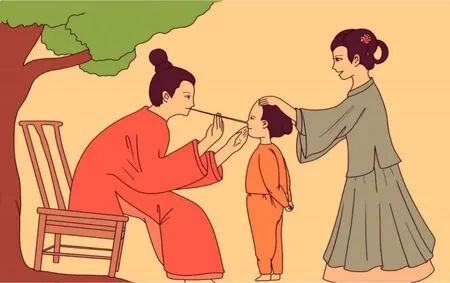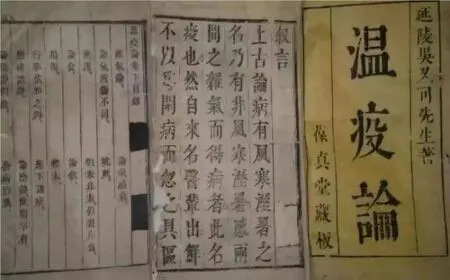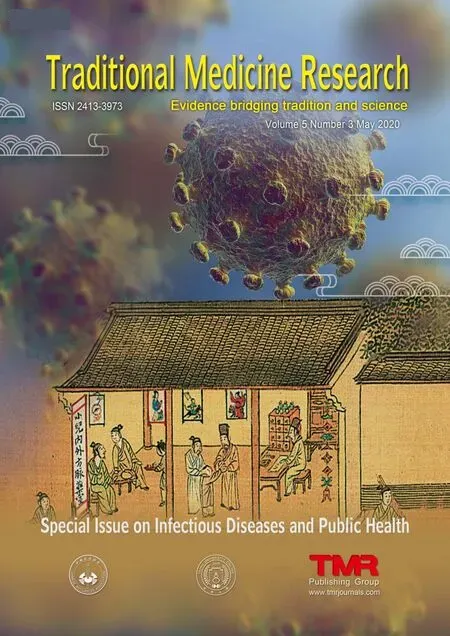Overview of the plague in the late Ming Dynasty and its prevention and control measures
Qiu-Hua Li,Yue-Hai Ma,Ning Wang,Ying Hu,Zhao-Zhe Liu
1The Second Hospital of Liaoning University of Chinese Medicine, Shenyang 110034, China; 2Shengjing Hospital of China Medicine University,Shenyang 110004,China; 3Northern Theater Command General Hospital,Shenyang 110016,China.
Abstract
Keywords:Late Ming dynasty,Plague,Infectious diseases,Traditional Chinese medicine,Prevention and control
Background
There have been many plagues in Chinese history, all of which have caused great losses to the people during the time.The records of plague in Chinese medicine can be traced back to the Shang Dynasty (1600-1046 B.C.E).As recorded in theShanhaijing(The Classic of Mountains and Rivers) (publication year unknown) of the Qin Dynasty (221-207 B.C.E.), people at the time determined the severity of epidemics through divination.In the late Eastern Han Dynasty (184-220 C.E.), natural disasters and wars led to a great plague of “countless bodies lay exposed in the fields, and there’s no crow for miles around.” Deeply touched by the suffering of people under the plague, the famous doctor Zhang Zhongjing (150-219 C.E.) studied ancient books to find a cure for typhoid fever.In 210 C.E., he completed his famous medical monograph“Treatise on Exogenous Febrile Disease”(219 C.E.).
After the establishment of the Ming Dynasty(1368-1644 C.E.), the medical system underwent constant improvement.The imperial hospital and the prestige medical center set up by the central government and the Welfare Pharmacy set up by the local government carried out a variety of prevention and control measures against the epidemic.However,as a result of imperial corruption,natural disasters,and frequent wars, the plague that occurred during the late Ming Dynasty (1551-1644 C.E.) became the second greatest plague in Chinese history after the outbreak of plague at the end of the Han Dynasty.
During the multiple struggles with the plague, a group of great medical experts emerged and devised a series of prevention and control measures as well as some advanced technologies that were very effective for the prevention and control of plague.The present manuscript reviews the general situation and control measures of the plague during the Ming Dynasty, with the aim of providing a basis and reference for the prevention and treatment of plagues in the present day.
Overview of the plague during the late Ming Dynasty
According to historical records, an extremely cold weather disaster occurred during the late Ming Dynasty of China, which meteorologists refer to as the“Little Ice Age of the Ming Dynasty”[1].At that time,the annual average temperature of China was well below the normal level.In summer, drought was followed immediately by flooding.The winters were extremely cold, and heavy snowfall occurred in Hebei,Fujian, and Guangdong Provinces.The severe cold in the north regions caused the widespread southward movement of rainfall areas, which reduced the production of food significantly.Especially in the northern regions, long-term droughts accompanied by widespread famine occurred frequently, which led to disasters throughout the Ming Dynasty (1368-1644 C.E.) [2].According to available statistics, there was one or more kinds of natural disaster every year from the Wanli reign (1573-1620 C.E.) to the Chongzhen reign(1628-1644 C.E.).From the first year to the 17th year of the Chongzhen reign (1628-1644 C.E.), there were floods,droughts,snowstorms,and locust plagues.In particular,drought often coexisted with other natural disasters[3].
Based on a statistical analysis of plague occurrence over various periods of the Ming Dynasty, as well as analysis of the major distribution areas and the number of years affected by plague, the occurrence of plague increased to once a year or more, with the number of affected counties reaching 1,878 in the later period of the Ming Dynasty (Table 1).We analyzed the provinces with the highest number of major plagues and found that the number of years affected by plague in these provinces also showed an increasing trend(Table 2).
The great plague of the late Ming Dynasty was mainly concentrated in northern China and was not a national outbreak like the plague of the late Eastern Han Dynasty.The population of the Ming Dynasty was characterized by smaller numbers of people in the north and greater numbers in the south.The loss of population in the late Ming Dynasty was mainly due to the large-scale famine caused by the Little Ice Age and the destruction caused by war [4].In addition to the natural disasters mentioned above, a nationwide drought occurred over a period of four years beginning in 1641.In 1643 C.E., “knotty disease” occurred in Beijing, a term that was used to describe bubonic plague patients suffering from lymphadenopathy.Bubonic plague was transmitted by the bacteriumYersinia pestisfrom parasites such as fleas on mice,and the hallmark of infected humans was lymphadenopathy[5].
The immediate effect of drought was the presence of large numbers of refugees who fled the country because of food shortage.The people and the rats moved around together, which resulted in the bacteriumY.pestisto be passed on to the refugees and spread to wider areas.During the plague at the end of the Ming Dynasty,“most of children died of the plague,and more than 200,000 dead people were carried out through the city gates.” Between August and December in 1643 C.E., the conservatively estimated death toll was one-fifth of population of Beijing.In April 1644 C.E., the rebel leader Li Zicheng faced a city of pestilence and terror when his army invaded Beijing, the capital of the Ming Empire.Some studies have suggested that the death toll from the plague at the end of the Ming Dynasty would be on a 10 million scale[6-7].
To sum up, the successive natural disasters caused by the climate of the Little Ice Age were the main natural factors of the plague epidemic during the late Ming Dynasty.We divided Ming Dynasty into three time frames:the first was 1368-1451 C.E., with a total of 83 years; the second was 1451-1550 C.E., with a total of 100 years; and the third was 1551-1644 C.E.,with a total of 94 years.It was reported that during 1551-1644 C.E., there were 78 recorded cases of plague.The number of counties with plague reached 1878, which was more than the summary of the early and middle Ming Dynasty [8].The data in Table 1 and Table 2 were extracted from the studies of Yao xueyin et al.and Zhang Tao et al.[7,8].
The medical system of the Ming Dynasty
The medical system of the Ming Dynasty was basically inherited from that of the Yuan Dynasty (1271-1368 C.E.).During the Yuan Dynasty, medical management and the medical system relied on the imperial hospital to handle medical affairs.Various medical officers of the Yuan Dynasty performed their duties respectively,and they developed and perfected the original systems of the Song Dynasty (960-1279 C.E.) and Jin Dynasty(1115-1234 C.E.) in terms of the selection,examination, and reward systems.In particular, the medical officers of the Yuan Dynasty enjoyed a special social status with more opportunities for promotion.Many Confucian scholars also abandoned literature to practice medicine [9].The founding emperor Zhu Yuanzhang overthrew the Yuan Dynasty and established the Ming Dynasty.He constructed his own medical system based on the original system of the Yuan Dynasty (Figure 1A).In addition, there were many deaths as a result of frequent floods, droughts,and plagues.These disasters had very serious consequences, including severe socioeconomic damage.In ancient China, the social economy was dominated by agriculture, and the role of the population as an agricultural labor force could not be replaced.Massive loss of life inevitably led to the desolation and idleness of a large number of lands,resulting in regression of the economy.At the same time, people promoted a better medical system and response measures in the struggle against natural disasters[10].
Zhu Yuanzhang (1328-1398 C.E.) formulated a series of welfare policies to assist the civilians.He set up welfare homes to take in poor and homeless individuals, which were built with government funds.He also established the Welfare Pharmacy, where poor civilians could obtain free medicines when they were ill.In addition,he was particularly concerned about the funeral arrangements of poor families.The government paid for the burials of poor families who could not afford to bury the dead.
The medical system of the Ming Dynasty was mainly composed of four parts: a central medical institution, imperial medical institution, local medical institution, and folk medical organization.The central medical institution mainly set up imperial hospitals,which were divided into the Nanjing subdivision and Beijing subdivision.There were drug storages in the imperial hospitals, with one ambassador and one deputy ambassador each in charge of drugs.Each year,the distribution of medicinal materials was administrated by the place of origin and was classified by the quality of medicinal materials, processing methods,degree of dryness,and dampness[11].

Table 1 Summary of plague occurrence during different periods of the late Ming Dynasty
The drugs were checked and put into the storehouse by the imperial physician and ambassador of the imperial hospital.The ceremony department sent a person to supervise and register the drug, and two copies were made of all records.The prince’s residence established prestigious doctors’ hospitals, in which a sixth-ranked medical officer, a seventh-ranked medical officer,and several eighth-rank medical officers treated the patients together.The medical officers were recommended by the imperial hospital and appointed by the Ministry of Administration.The outstanding pharmacist Li Shizhen (1518-1593 C.E.) served as a medical officer in a prestigious doctors’ hospital[12-13].
There were doctors, medical assistants, and medical officers in the local, state, and county governments and/or border guard station as well as in the places where people gathered.In the medical affairs system of the Ming Dynasty, specific regulations were devised by medical scientists from the content, method, and attitude of studying to the ideological quality, moral quality,and attitude of treating patients[14].
The imperial hospital was responsible not only for medical work but also for the teaching and training of doctors.In addition, the imperial hospital participated in the government’s rescue work in the event of plague.
At the local region, the Welfare Pharmacy existed mainly to cure the poor, sick, and socially vulnerable groups during peacetime and was responsible for disaster relief in during a plague outbreak [15].The original intention of the Welfare Pharmacy was to benefit the people and to help poor and sick individuals afford the cost of seeing a doctor or to buy medicine.Therefore, the imperial court implemented a subsidy policy for drug administration in the Welfare Pharmacy.In this way,the price of drugs was far lower than that in the market, making medicine more affordable for people in the lower classes [16].The Welfare Pharmacy would also distribute medicine free of charge to poor individuals and disaster victims if they really had no ability to pay (Figure 1B).The Welfare Pharmacy was mainly created to aid ordinary people and was subsidized by the government to promote public welfare.This picture is excerpted from Qiu Ying’s picture “Riverside Scene at Qingming Festival”from the Ming Dynasty.
Understanding of measures to control plague in the Ming Dynasty
For hundreds of years during the reign of the Ming Dynasty, the relevant systems and countermeasures instituted by various individuals during the struggle against plague played a positive role.
Isolation and burial measures
Isolating the sick helps prevent the spread of infectious diseases.Xiao Daheng (1532-1612 C.E.), a politician of the Ming Dynasty, pointed out in his bookYisuji(Tatar Folk Record) that “people suffering from infectious disease should be isolated from their parents,brothers, wives, and children.” Burying the bones of the dead is also an indispensable measure in the treatment of plague [17].The lethality of plagues often leads to large numbers of deaths, and severe plagues often lead to the desolation of villages and the spread of dead bodies.The decomposition of bodies that are not buried in time and the breeding of mosquitoes and flies worsen environmental hygiene, which in turn exacerbate the disasters, creating a vicious circle.The government of the Ming Dynasty actively buried the dead bodies of plague victims to prevent further deterioration of the environment[18].

Figure 1 The founding emperor of the Ming Dynasty and Welfare pharmacy in the Ming Dynasty.
In 1643 C.E., after the Beijing plague occurred, the government released light criminals to avoid jail crowding, allocated funds to treat epidemics, and buried the dead[19].When the rebel leader Li Zicheng(1606-1645 C.E.) arrived in Beijing at the end of the Ming Dynasty,the Ming Army in the city was so badly quarantined by the plague that more than half of them died.There were not even 10,000 soldiers who could defend the walls of the capital.Every day, soldiers,peddlers, and laborers died in droves, and there was even no beggar in Beijing city[7].
Medicine delivery and disease control
The imperial hospital had an important responsibility to participate in the government’s treatment strategies when encountering a plague.Treatment methods included the preparation of drugs, soup liquids, pills,and plasters.However,the main objects of rescue were the royal nobles in the capital city [14].In 1560 C.E.,there was a famine in the suburb of Beijing.People who had no place to live swarmed into Beijing because of the disaster.After the emperor summoned the ministers for deliberation, he allowed the imperial hospital to undertake the treatment of the sick civilians[20].At the time of the plague, it was easy for people to become panicked when faced with the danger of infection.Therefore, the Ming government arranged for the medical officers of the Welfare Pharmacy to quantify the epidemic situation, diagnose and treat the patients, and distribute medicine when plague was prevalent.They also set up special medical stations to receive homeless patients and selected highly skilled doctors to take care of the sick[20].
In 1581 C.E., plague occurred in Jiaocheng County of Shanxi Province.Many civilians were infected with the fungus, and their health was in serious danger.The county magistrate collected doctors and medicines from the Welfare Pharmacy to treat the infected civilians[21].
After analyzing and summarizing the measures taken by the Ming government to cure the plague, we find that the local government would immediately report the situation to the central government when plague is prevalent.Then, the central government issued corresponding measures and directives,allocated the funds, opened the granaries, dispatched the doctors, distributed medicines, and curtailed the cost of official travel to help the affected residents.Local governments organized workers to bury bodies and isolate people and rewarded or punished officials and doctors involved in treating the epidemic.Because of traditional clan and blood relationships, some people helped each other and shared medical resources spontaneously.In addition,some prominent gentry and good Samaritans offered to assist the government in activities such as giving medicine and food, raising funds, burying bodies, adopting orphans, and so on.These people were commended by the government and were even awarded some honorary positions.In some remote villages,people prayed not to be harmed by the plague by the way of worship and prayer (Figure 2)[22-24].
However, in the middle and late Ming Dynasty, the Welfare Pharmacy was not well managed, and its activities were inefficient because of war, shortage of funds,and regime corruption.
Prevention and treatment
The Jiajing reign (1522-1566 C.E.) of the Ming Dynasty also personally wrote prescriptions and made them into “small decoction for epidemic relief.” He requested the Ministry of Rites to distribute the prescriptions to the civilians.In addition, the Ming Dynasty invented the process of variolation to prevent smallpox.This became a precursor of artificial immunity and thus occupies an important position in the history of medicine [25] (Figure 3).InBencao Gangmu(Compendium of Materia Medica), the outstanding pharmacist Li Shizhen instructed that the clothes of the infected should be fumigated at high temperature so as to reduce the probability of transmission to the family in the event of a plague[26].The owner of a famous bookstore in Hangzhou, Hu Zhengxin (birth and death years unknown) also mentioned the method of steam disinfection in his bookJianyibeiyanfang(Simple Method of Preparing and Checking Prescription,1641 C.E.) [27].In his bookShoushibaoyuan(Prolonging Life and Preserving the Origin,1615 C.E.), Gong Tingxian (1368-1644 C.E.)of the Ming Dynasty listed the ingredients of“Tu Su wine (a wine consumed during ancient Chinese Spring Festival), with the Houpo (Magnoliae officinaliscortex), Jiegeng (Platycodonis Radix),Fangfeng (Saposhnikoviae Radix), Guizhi (Cinnamomi Ramulus), Baizhu (Atractylodis MacrocephalaeRhizoma), Cangzhu (Rhizoma Atractylodis), Chuanwu(AconitiRadix), Baizhi (Angelicae dahuricaeRadix),Dahuang (Rhei Radix et Rhizoma), Chenpi (Citri Reticulatae Pericarpium), Tanxiang (Santali AlbiLignum), Doukou (Amomi RotundusFructus), Huajiao(Zanthoxyli Pericarpium), Huoxiang (Pogostemonis Herba), Weilingxian (Radix et Rhizoma Clematidis),Gancao (Glycyrrhizae Radix et Rhizoma), Liquor and Spirits.” He pointed out that this kind of wine could block the plague,and he suggested that patients ignited moxa pillar at the corner of the bed to produce moxa smoke, which could be used as an antibacterial and antiviral agent [28-29].Mingshilu(Record of Ming Dynasty) recorded that in the late Ming Dynasty, an official in Fujian Province invented bloodletting therapy to treat the plague.Nearly 10,000 people were treated with bloodletting every day during that period[30].It was recorded in “Jingyuequanshu(Jing-yue's Complete Works)” (1624 C.E.), written by Zhang Jingyue (1563-1640 C.E.), that the use of “Fujian tea cake” (agalloch eaglewood, symplocos paniculata,cattail pollen, liquorice, musk, and bottle brush herb were collected together and ground into a fine powder and then modulated by glutinous rice soup and shaped to a pill cake) was helpful for oral disinfection and for preventing diseases that entered through the mouth[31].Wu Youke (1582-1652 C.E.) pointed out in hisWenyilun(Treatise on Epidemic Febrile Diseases) that pestilent Qi (a class of exogenous pathogens with strong pathogenicity and infectivity) did not definitely occur in a contagiously epidemic situation.Therefore,the doctrine of pestilent Qi was not convincing[32].
Whether a person contracted the epidemic disease depended on the existence of pestilence.Pestilence is one of the miscellaneous Qi, which existed every year.The pestilence caused infection of old and young people.Wu Youke doctrine speculated on the presence of pathogens and further emphasized the infectious nature of the plague,on the basis of the work by Zhang Zhongjing (150-215 C.E.).Wu Youke also pointed out that the plague was contracted by the mouth and nose and spread by inhalation.He stressed the importance of isolating patients and invented a rather effective treatment of plague, the “Dayuan decoction,” which consisted of Binglang (Arecaesemen), Houpo(Magnoliae officinaliscortex), Caoguo (Fructus Tsaoko), Zhimu (Anemarrhenae Rhizoma), Shaoyao(Paeoniae Radix Alba), Huangqin (Scutellariae radix),and Gancao (Glycyrrhizae Radix et Rhizoma).He was proved to be a master pioneer in the treatment of febrile diseases in China[33](Figure 4).
Modern studies have confirmed that Dayuan decoction has a good curative effect in the treatment of some acute infectious diseases, such as typhoid fever,malaria, and influenza [34].The use of Dayuan decoction 3 to 10 days after the onset of severe acute respiratory syndrome is associated with good clinical efficacy [35].Dayaunyin has a significant antipyretic effect by decreasing the levels of interleukin-6 and tumor necrosis factor-α in serum and reducing the activity of myeloperoxidase in liver tissue.
Conclusion
During the Ming Dynasty, the medical system as well as some of the thinking and methods of prevention and control of the plague were historical and progressive.Some outstanding physicians such as Wu Youke appeared in this period.His theory of plague prevention and control have a profound influence on the formation and development of pestilence treatment in later generations.Wu Youke’sWenyilun(Treatise on Epidemic Febrile Diseases) plays a connecting role in the academic development of epidemic febrile diseases and lays a theoretical foundation for the establishment and development of the school of epidemic febrile diseases during the Qing Dynasty.However, because of natural weather disasters, corruption, and war, the government of the late Ming Dynasty failed to control the plague.In the late Ming Dynasty, people accumulated rich experiences and devised measures of prevention and control in the struggle against plague.These methods and experiences have also had a positive guiding influence on the prevention and control of plague in the present day.

Figure 2 Prevention and control measures of plague

Figure 3 Variolation was invented in the Ming Dynasty to prevent smallpox.

Figure 4 Treatise on Epidemic Febrile Diseases (1642 C.E.).
 Traditional Medicine Research2020年3期
Traditional Medicine Research2020年3期
- Traditional Medicine Research的其它文章
- Medical workers in traditional medicine who sacrificed their lives in the battle against COVID-19 deserve to be remembered forever
- Network pharmacology studies on the effect of Chai-Ling decoction in coronavirus disease 2019
- The potential application of the traditional Chinese herb Exocarpium Citri grandis in the prevention and treatment of COVID-19
- The role of natural products in regulating pyroptosis
- Complementary and alternative medicine in European countries—legislative framework
